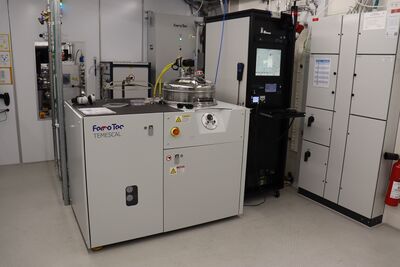Specific Process Knowledge/Thin film deposition/10-pocket e-beam evaporator
Feedback to this page: click here
All contents by DTU Nanolab staff
E-Beam Evaporator (10-pockets)

The 10-pocket electron-beam evaporator allows line-of-sight deposition of 10 different materials. In line-of-sight deposition only the surface of the sample facing the source directly is coated, which is useful for example for lift-off. This particular machine was purchased by Nanolab in 2023. It was made by Temescal, a company owned by FerroTec, and is very similar to the other Temescal e-beam evaporator bought by Nanolab in 2018, which we call the E-beam Evaporator (Temescal).
In both of the Temescal e-beam evaporators, one material can be deposited at a time, and you can deposit many layers one after another. Up to four 6" wafers or three 8" wafers can be loaded at a time for deposition on the surfaces facing the evaporation source, or up to one 6" wafer can be loaded for tilted deposition. Using sample holder inserts and clips, you can deposit on samples of different sizes and shapes. Notice that if you want to lift off layers deposited on 8" wafers you may need to adjust the lithography parameters as deposition on the edges of the substrates will at times be from angles away from the perpendicular to the substrate surface. This is because, unlike the HULA (high uniformity lift-off assembly) normally used for 6" and smaller substrates, the holder for 8" wafers is not optimized for lift-off .
Some special features of the 10-pocket system compared to the other Temescal e-beam evaporator are:
- sample heating up to 250 °C
- low oxygen flow possible
- A few nonmetals, namely silicon, silica, and alumina, are available. Please only deposit these materials in the afternoon before a scheduled service as they can cause a lot of flakes in the machine.
You need additional training to use heating and oxygen flow.
The user manual, user APV, and contact information can be found in LabManager:
E Beam Evaporator (10-pockets) in LabManager
Training videos may be found here:
Process information
- Acceptance test report with results from October 2023. Evaluates thickness uniformity, line-of-sight deposition, sheet resistance uniformity, heater functionality, vacuum performance, and oxygen flow.
Materials for e-beam evaporation
These materials are available in the 10-pocket e-beam evaporator:
- Aluminium (Al)
- Aluminium oxide (Al2O3)
- Chromium (Cr)
- Copper (Cu)
- Germanium (Ge)
- Gold (Au)
- Nickel (Ni)
- Platinum (Pt)
- Silicon (Si)
- Silicon oxide (SiO2)
- Silver (Ag)
- Titanium (Ti)
In addition to the pure metals you are welcome to experiment with depositing their oxides by adding oxygen during growth, though we expect the resultant films to be O-poor. E.g., TiOx films deposited with a low oxygen flow during acceptance testing had a stoichiometry of approx. TiO1.4 to TiO1.8. Please talk to staff if you wish to work with the oxides.
Most of these materials on the list above are fixed and will be present in the machine for at least a year at a time. This applies to: Al, Cr, Au, Ni, Pt, Si, Ag, and Ti.
A few of them are deposited from liners and may be exchanged on request. This applies to: Al2O3, Cu, Ge, and SiO2.
If you wish to evaporate a metal that is not on this list, you should use the E-beam Evaporator (Temescal), where you can request almost any metal. For other materials you may be able to use sputtering or ALD - see the list of available materials on the Overview page.
Thickness measurement, deposition rate and process control
Read about how the machine measures the thickness of the growing film using a quartz crystal monitor, how accurately you can control the rate/thickness, and other useful information about e-beam deposition here: Thickness, rate, process control.
Particulates in the films
Read about optimizing film quality including how to minimize the number of particulates in Au films in the E-beam evaporator (Temescal).
| Purpose | Deposition of metals |
|
|---|---|---|
| Performance | Film thickness |
|
| Deposition rate |
| |
| Thickness uniformity |
| |
| Thickness accuracy |
| |
| Process parameter range | Process Temperature |
You can see the approximate temperature from the readout of the thermocouple in the chamber. |
| Process pressure |
| |
| Source-substrate distance |
| |
| Substrates | Batch size |
|
| Substrate material allowed |
Almost any that can be securely attached and will not outgas.
| |
| Material allowed on the substrate |
Almost any material that does not outgas and where there is no risk of fragile structures dislodging and falling into the machine during the deposition.
|
* See table in manual with max. allowed rate and cumulative thickness. If you would like to deposit more than the limit in the table, please request permission from metal@nanolab.dtu.dk no matter if it is a single layer or a number of deposition runs adding up to a total thickness exceeding the limit. This is so we can ensure that enough material will be present and that the the machine can be cleaned up as needed as thick layers can cause flaking.
** Defined as the ratio of the standard deviation to the average of the measurement made using the DektakXT. For further details see the acceptance test.
